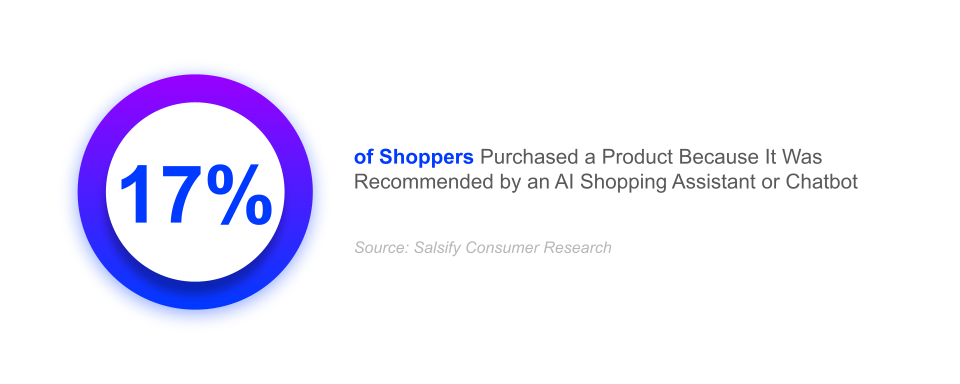Agentic AI vs. Generative AI: How Can Brands Prepare Their Product Content for the AI Shopping Revolution?
Written By: Yvonne Bertovich
2025: A year of always-on, “ambient shopping” and artificial intelligence (AI), and, therefore, the impetus of the AI shopping revolution.
Ambient shopping — that is, a shopping experience that’s seamless and spontaneous and occurs while scrolling on social media, using streaming services or apps, etc. — and AI go hand in hand (or fingertip and touchscreen), as consumers increasingly rely on both generative AI (GenAI) and agentic AI (i.e., autonomous shopping assistants) for product research.
According to Salsify’s “2025 Consumer Research” report, 28% of shoppers in the U.S. and U.K. find AI-powered shopping assistants or chatbots valuable, with the highest prevalence among millennials (32%), Gen Xers (31%), and male shoppers (44%).
This enthusiasm has only grown, as more recent sentiments reveal that 50% of shoppers in the U.S. and U.K. say AI tools, such as chatbots and gift guides, would improve their holiday shopping experience, according to Salsify’s “2025 Holiday Pulse Report.”

However, for brands to avoid becoming invisible in this new search landscape, they must optimize their content for both agentic and generative AI — but how?
Here’s a breakdown of the fundamental differences between agentic AI and generative AI and actionable strategies for optimizing product content for (and/or with) both.
Agentic AI vs. Generative AI in Ecommerce: Overview and Differences
Here’s a quick overview of AI’s evolving role in ecommerce, a breakdown of agentic AI vs. generative AI, and the differences between these two AI types.
AI’s Evolving Role in Ecommerce
“Tools like machine learning (ML), natural language processing (NLP), and large language models (LLMs) have the potential to support ecommerce by doing exactly what ecommerce did to in-store shopping: filling in the gaps,” Rob Gonzalez, Salsify co-founder and chief strategy and innovation officer, shared in a new AI guide.
These discovery “gaps” Gonzalez is referring to are when consumers have specific preferences, needs, and/or a problem to solve — but they’re open to different products and brands that may not be immediately available at their local brick-and-mortar.
In this vein, ecommerce and online shopping opened shoppers up to a world of options compared to traditional in-store shopping experiences. But even in this advanced age of the digital shelf, search results and product detail pages (PDPs) aren’t always perfect.
Modern shoppers want to learn more about various items available, explore recent trends, compare prices, read reviews, and seek advice or recommendations from influencers or experts.
This is where agentic and generative AI are tagging in.
What’s Agentic AI in Ecommerce?
Agentic AI is designed to act autonomously. This means it can make decisions and solve problems with minimal human intervention. Agentic and autonomous AI agents can perceive their environment, plan and execute actions, and often learn and adapt over time.
Agentic AI examples in ecommerce include autonomous shopping assistants like Amazon’s Rufus or Walmart’s Sparky.
What’s Generative AI in Ecommerce?
Generative AI, on the other hand, is artificial intelligence that can generate text, images, video, code, or other data, often serving as a content creation tool. Its output is based on learned patterns from input.
GenAI can assist with research, ideation, analysis, and, of course, production.
Examples of generative AI in ecommerce can include tools like ChatGPT, Claude, Gemini, DALL-E, and Midjourney.
Differences Between Agentic AI and Generative AI
Agentic AI can be considered more advanced than generative AI and has slightly different uses and outcomes — in a way, it’s generative AI with the added ability of automation and workflows. It takes your input further and can perform repeatable or nuanced actions without further prompting.
Of course, both types of AI tools can be applied in ecommerce — particularly by shoppers throughout their buying journeys.
| AGENTIC AI | Uses for Shoppers | Limitations |
|
||
| Uses for Ecommerce Professionals | Limitations | |
|
||
| GENERATIVE AI | Uses for Shoppers | Limitations |
|
|
|
| Uses for Ecommerce Professionals | Limitations | |
|
|
How Do Consumers Use Agentic AI and Generative AI in Their Shopping Journeys?
Both agentic AI and generative AI can be used throughout the discovery, consideration, and decision stage of the buyer’s journey. As the ways shoppers incorporate AI tools evolve, so do these tools, and vice versa.
How Shoppers Use Generative AI and Generative AI Examples
According to research by ecommerce personalization tool Bloomreach, “61% of U.S. shoppers have used general-purpose AI tools like ChatGPT or Gemini to help them shop online.”
And, as noted by EMARKETER, “58% of global consumers have already replaced traditional search engines with GenAI tools,” and 68% of these consumers want search options that “aggregate product data across search engines, social media, and retailer sites.”

Generative AI tools can be particularly helpful in the discovery stage. They’re even edging out other channels this year, like product review websites (e.g., Wirecutter, CNET), gift guides (e.g., blogs), online forums (e.g., Reddit), delivery apps (e.g., Instacart), and podcast ads when it comes to finding gift ideas: 9% of shoppers use AI chatbots like ChatGPT to discover gift ideas, according to Salsify’s holiday consumer research.
Millennial shoppers (13%) are most likely to use AI chatbots to discover gift ideas, followed by Gen Zers (11%), Gen Xers (8%), and baby boomers (2%).
When using generative AI, shoppers likely have some idea of the item they’re looking for and for what purpose; however, with agentic AI, things can get a lot more nuanced.
How Shoppers Use Agentic AI and Agentic AI Examples
According to Capital One Shopping, nearly 13 million orders are placed globally on Amazon every day, making the rollout of Amazon’s Rufus, an autonomous shopping agent, particularly impactful for shoppers.
Since Rufus can answer a wide range of questions, according to Amazon, it can help customers at any stage of their shopping journey. For example, shoppers can ask, “What do I need to make a soufflé?” or “What do I need for a summer party?” and Rufus can fill in the gaps.

Image Source: Amazon
Walmart’s Sparky touts similar proficiency: recommending items for shoppers fast, scouring reviews for them, and lending in-depth insights into product capabilities that might not be readily available on PDPs.
“Whether they’re picking and recommending products or getting to know your preferences, it’s painting a picture of what a world with an AI assistant in your pocket could look like,” Lauren Livak Gilbert, Digital Shelf Institute (DSI) director and ecommerce thought leader, shared on LinkedIn from Retail’s Big Show.
In your pocket isn’t an overstatement, either: 59% of consumers share that smartphones are their preferred device for online purchases, with 30% even making a purchase from their smartphone while shopping in a physical store, according to Salsify consumer research.
AI Shopping Assistants and Chatbots Both Fill Gaps, and Usage Overlaps
According to Bloomreach’s survey, “respondents cited time savings as the biggest benefit of AI shopping assistants, followed by easier navigation and better product recommendations.”
It tracks: 17% of shoppers purchased a product because it was recommended by an AI shopping assistant or chatbot, according to Salsify consumer research.

But how do brands ensure their products are recommendation-ready for both agentic AI and generative AI?
Brands must transition from traditional search engine optimization (SEO) to generative engine optimization (GEO) — while considering the capabilities of autonomous shopping agents.
From SEO to GEO: How To Structure Product Content That’s Consumable for AI
Humans and AI continue to evolve to each other’s preferences and capabilities. Shoppers, in particular, are learning that finding the products, brands, and answers they’re looking for with AI tools can come from increasingly personalized and conversational queries.
As such, keyword stuffing product content — i.e., traditional SEO — won’t be the way to win results with agentic and generative AI tools, especially as search changes to low or no click.
Instead, it’s GEO, achieved with a combination of detailed product data, reviews, multimedia, FAQs, and other cogent content that AI tools prioritize when making suggestions to shoppers.
How Brands Can Structure Product Content, FAQs, and More for AI Models To Answer Consumer Questions
How autonomous shopping agents evaluate and recommend products isn’t so disparate from what fuels consumer decisions: They’re looking for compelling, consistent content and product experiences.
This means brands must build comprehensive, structured product content for both AI types (and any others) to interpret.
No, not just a headline with a keyword, body copy with said keyword a few more times, and a handful of bullets. While these parameters should still be satisfied, brands must provide nuanced and specific information about their products and capabilities, including FAQs, technical specifications, lifestyle imagery descriptions, and more.
5 Tips for Building Product Content Consumable for AI
- Leverage reviews — both positive and negative — to give shoppers and AI tools a holistic view of your products and reputation.
- Use social listening (especially on Reddit and TikTok) to better understand what questions shoppers are asking about your products (and whatever else they're saying) to cultivate conversation and fill out FAQs.
- Incorporate lifestyle imagery, videos, and user-generated content (UGC) with detailed descriptions and appropriate alt text.
- Ensure PDPs and brand content are optimized for mobile to allow for seamless shopping experiences.
- Maintain authenticity and consistency across your brand’s digital and physical shelf presence.
Preparing for the Next Wave of AI Shopping Tools
Brands can prepare for the next wave of AI shopping tools — and the continuing shopping revolution — by creating rich, multi-dimensional product experiences that work across current and emerging AI platforms.
“Simply put, both AI and humans are at their best when they’re working together,” Gonzalez shares in the guide. “This ‘copilot’ model enables humans to innovate, create, and supervise, while positioning AI as a tool for doing more and doing it better.”
Becoming a Leader in AI for Ecommerce
Download the guide to learn why AI is a powerful addition to creating compelling product experiences and how it can enable brands to do more (and do it better).
DOWNLOAD GUIDEWritten by: Yvonne Bertovich
Yvonne Bertovich (she/her) is a senior content marketing specialist at Salsify, reporting from Tampa, Florida. With a longtime passion for research, she enjoys flexing her perspective on ecommerce, trends in consumer behavior, and health and wellness.
Recent Posts
5 Ecommerce Tips To Help Marketers Enter the New Year Stress-Free
How Many Digital Sales Channels Do Shoppers Review Before Purchasing Products?
What the Data Says About Consumer Interest in AI Shopping Agents
Subscribe to the Below the Fold Newsletter
Standing out on the digital shelf starts with access to the latest industry content. Subscribe to Below the Fold, our monthly content newsletter, and join other commerce leaders.

.svg)